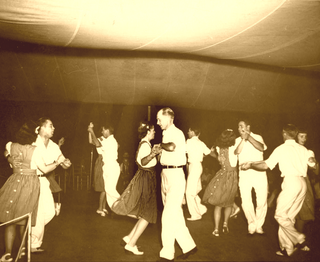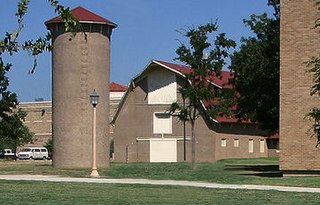The club's primary goal is to promote and advance square dance as a recreational activity. Typically clubs accomplish this goal through the following activities:
- Providing classes and other training opportunities to new, as well as experienced dancers
- Showcasing the activity through public performances
- Organizing dances
- Participation in other associations dedicated to the promotion and advancement of square dancing
- Providing employment and training opportunities to square dance callers.
This is not an exclusive list, and square dance clubs are constantly on the look out for new ways to achieve their goals. Associations, partnerships and other cooperative ventures have become increasingly more important to square dance clubs. Membership in square dance clubs seems to have peaked in the late '70s and early '80s, and has gradually decreased since that time.
Classes and training for dancers
Providing classes and training opportunities is the main activity for the majority of square dance clubs. This activity develops competent dancers, a core membership for the club, club solidarity and feeling, and a renewable base for the sustainability of the club. Most clubs start classes in September and/or January, although strategies are being developed for starting classes more often.
Callerlab recommends that the Mainstream program be taught in no less than 56 hours. Depending on the length of the individual class and how often one meets, it can take a half year or longer to learn the full program. Therefore, consideration is being given to many different ways to quicken the learning curve, and to get new dancers on the dance floor.
Callerlab also dictates what the plus, advanced 1 and 2, and 4 levels of challenge programs are.
Callerlab not only has a number of American callers that are members, but callers from all over the world.
In Europe, most notably in Denmark, there have been recognized a series of partial dance levels with corresponding dances available at those partway points (Mainstream 23, 45, 53, 69). The American Callers Association also has a simplified program, called "1". In America, clubs sponsoring classes often hold "Red-light/Green-light" dances, where alternating tips are called at a level where class members can participate. These accommodations allow dancers to begin attending dances quicker in the learning cycle.
Some clubs, especially those with younger or more motivated dancers, teach at accelerated rates. As an example, Tech Squares, associated with Massachusetts Institute of Technology, teaches the longer Plus program in one semester (12 classes of roughly 90 minutes of teaching time). Other clubs have reported success with intensive courses of one or two weekends to learn the Mainstream level, while other areas offer a "Five Saturday, or Sunday" program to instruct new students in the program.
This is a way of bringing public attention to the club, with the hope of recruiting more members. Public performances may be those done in public areas (malls, fairs, exhibitions) or it may refer to televised performances.
Organizing dances
Organizing dances is one of the primary activity of clubs. In addition to sheer enjoyment, dances provide the club's members and members of other clubs the opportunity to practice the skills learned in classes. It also gives the club an opportunity to showcase itself to the wider square dance community, provides dancers an opportunity to socialize, and provides employment for callers.
Participating in associations
Square dance clubs participate in square dance associations of regional, area-wide, national and special interest character, as well as non-square dance association and organizations.
Employment and training for square dance callers
Employment of square dance callers is a key means of securing competent dancers for the club, and for the activity as a whole.
Callers will have resources available to them that the general public may not know about. By contacting a caller, you may find information on the activity in your area that is not widely publicized.
Training for callers is done by other callers; some of whom have been Certified by organizations. Training can be done in seminars and in week-long classes. A caller is never done with education as he/she is always trying to improve their craft.

A community college is a type of undergraduate higher education institution, generally leading to an associate degree, certificate, or diploma. The term can have different meanings in different countries: many community colleges have an "open enrollment" for students who have graduated from high school. The term usually refers to a higher educational institution that provides workforce education and college transfer academic programs. Some institutions maintain athletic teams and dormitories similar to their university counterparts.

A square dance is a dance for four couples, or eight dancers in total, arranged in a square, with one couple on each side, facing the middle of the square. Square dances are part of a broad spectrum of dances known by various names: country dances, traditional dances, folk dances, barn dances, ceilidh dances, contra dances, Playford dances, etc. These dances appear in over 100 different formations, of which the Square and the Longways Set are by far the most popular formations.

Gay square dance is square dance as it is generally danced in the Gay and Lesbian community. The first gay and lesbian square dance clubs formed in the mid-to-late 1970s in the USA. There are currently about eighty gay square dance clubs worldwide.

Modern western square dance is one of two American types of square dancing, along with traditional square dance. As a dance form, modern western square dance grew out of traditional square dance in the American West. The term western square dance, for some, is synonymous with "cowboy dance" or traditional western square dance. Therefore, this article uses the term "modern western square dance" to describe the contemporary non-historical dance which grew out of the traditional dance. Modern western square dance was the official dance of the United States from 1982 to 1993.
A caller is a person who prompts dance figures in such dances as line dance, square dance, and contra dance. The caller might be one of the participating dancers, though in modern country dance this is rare.
Lloyd Shaw (1890-1958), also known as Dr. Lloyd "Pappy" Shaw, was an educator, and is generally credited with bringing about the broad revival of square dancing in America. He was superintendent, principal, teacher, and coach for Cheyenne Mountain Schools in Colorado Springs, Colorado from 1916-1951, and taught folk dancing.
Do-si-do is a dance move.
Youth square dancing is square dancing among people up to their mid-twenties. In specific contexts, e.g., in qualification for some event, it may refer to dancers up to a particular age such as 18. It also may refer to a style of dancing that, while most popular among younger dancers, can be enjoyed by some older dancers.
Promenade is a basic dance move in a number of dances such as English Country Dance, contra dance, and square dance. The name comes from the French word for "walk", and is a good basic description of the dance action.

Agricultural education is the teaching of agriculture, natural resources, and land management. At higher levels, agricultural education is primarily undertaken to prepare students for employment in the agricultural sector. Classes taught in an agricultural education curriculum may include horticulture, land management, turf grass management, agricultural science, small animal care, machine and shop classes, health and nutrition, livestock management, and biology.
Tech Squares is a square and round dance club at the Massachusetts Institute of Technology. It was founded in 1967 and is still holding dances today. Tech Squares dances high-energy modern Western squares in an "all position" style, with no dress code or couples requirement. It has many student members. The club dances the Plus program, but many members also dance advanced and challenge levels.
A square dance program or square dance list is a set of defined square dance calls or dance steps which are associated with a level of difficulty. Programs and program lists are managed and universally recognized in modern western square dance.
Challenge square dance, also known as Challenge dancing, is modern western square dance focused on the puzzle-solving aspects of square dancing at the most difficult or "challenging" levels.

Traditional square dance is a generic American term for any style of American square dance other than modern Western. The term can mean (1) any of the American regional styles that existed before around 1950, when modern Western style began to develop out of a blend of those regional styles, or (2) any style that has survived, or been revived, since around 1950. The term Traditional Square Dance is also used in England to refer to dances collected from villages in the first half of the 20th century.

Bob Dalsemer is a square and contra dance writer and caller. He has called dances for more than 40 years and in more than 33 states, plus internationally in Canada, the Czech Republic, Britain, Belgium, Denmark and Russia. He wrote the book West Virginia Square Dances and Folk Dance Fun for Schools and Families. He has also compiled the cassette/book compilations Smoke On the Water: Square Dance Classics and When The Work's All Done: A Square Dance Party For Beginners and Old Hands.

CALLERLAB is the international association of square dance callers, and is the largest square dance association in the United States. CALLERLAB provides guidance and education, certifying caller coaches, maintaining standardized lists of calls and definitions, and generally promoting the square dance activity. After some initial work started in 1971, it was officially established in 1974 by several members of the Square Dance Hall of Fame. Callerlab makes it so people can dance anywhere in the world with uniform dance calls.

The New Haven Chargers are the athletic teams that represent the University of New Haven, located in West Haven, Connecticut, in NCAA Division II intercollegiate sports. The Chargers' 20 varsity athletics teams, eight men's and 12 women's, compete as members of the Northeast-10 Conference, with the exception of women's rugby which competes under USA Rugby. New Haven has been a member of the NE10 since 2008.

In the Philippines, disability is one of the social issues affecting a portion of the Philippines' population. To ensure the equality and rights of disabled persons, there are Philippine laws and policies that were passed regarding persons with disabilities (PWDs). There are also numerous non-government associations that seeks to encourage and help improve the wellbeing of people with disabilities.
The Square and Circle Club is a women's community service organization located in San Francisco. Founded in 1924, it is the oldest Chinese women's community service club in the United States. Throughout its history, the club has been active in its support of numerous San Francisco Chinatown community organizations and philanthropic causes.










